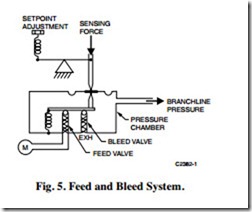FEED AND BLEED SYSTEM
The “feed and bleed” (sometimes called “non bleed”) system of controlling branchline pressure is more complicated than the nozzle-flapper assembly but theoretically uses less air. The nozzle-flapper system exhausts some air through the nozzle continually, whereas the feed and bleed system exhausts air only when the branchline pressure is being reduced. Since modern nozzle-flapper devices consume little air, feed and bleed systems are no longer popular.
The feed and bleed system consists of a feed valve that supplies main air to the branch line and a bleed valve that exhausts air from the branch line (Fig. 5). Each valve consists of a ball nested on top of a tube. Some pneumatic controllers use pressure balance diaphragm devices in lieu of springs and valves. A spring in the tube continually tries to force the ball up. The lever holds the ball down to form a tight seal at the end of the tube. The feed and bleed valves cannot be open at the same time.
A force applied by the sensing element at the sensor input point is opposed by the setpoint adjustment spring and lever. When the sensing element pushes down on the lever, the lever pivots on the bleed ball and allows the feed ball to rise, which allows main air into the chamber. If the sensing element reduces its force, the other end of the lever rises and pivots on the feed ball, and the bleed ball rises to exhaust air from the system. The sensor can be any sensing element having enough force to operate the system.
